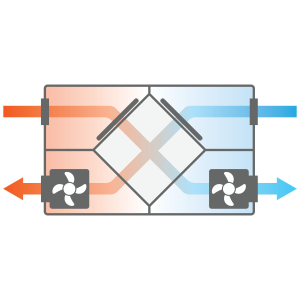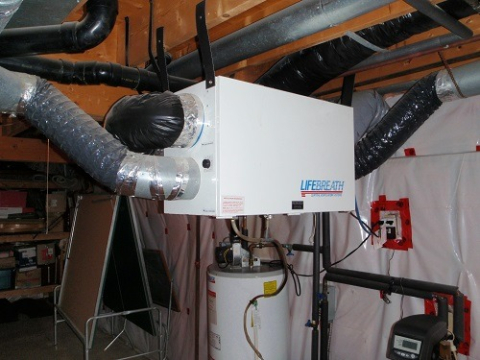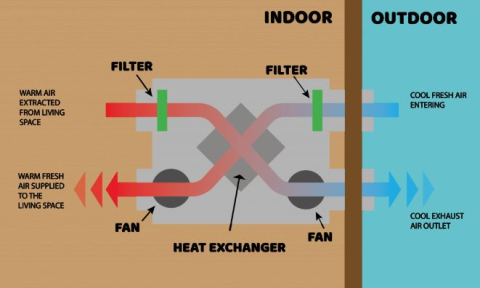
What are Heat Recovery Ventilators?


systems built into your home's attic or basement.)
The purpose of the Heat Recovery Ventilator (HRV) is to circulate and replace the stale, dry air inside your home with fresh outdoor air. Ventilating the home can let ‘heat’ escape, making you use more energy to keep the home warm. The HRV unit continuously replaces the air escaping, keeping the home warm and well-ventilated with clean, filtered air.
HRV's help keep your home healthier by eliminating bacteria and pollutants in the air with the built-in air filters, which do require cleaning or replacement every three months recommended by professionals.
One key factor to a home's energy efficiency is ensuring the house is as airtight as possible. It will ensure the heat’s ventilation works effectively so your home won't 'leak' heat.
The Heat Recovery Ventilator helps save us energy by transferring the warm air being pushed out of the house to the 'Heat Exchanger' (the diamond-shaped core), filtering the cool incoming air that will replace the warm air keeping the home well-ventilated.
Daily chores like doing the dishes, washing and drying laundry, and even showering can cause humidity levels to rise. The HRV's pull the humid and stale air through its ventilation, Heat Exchanger, and filters (shown in the diagram below), replacing and circulating clean air throughout the home, making it more comfortable.

How an HRV works:
HRV's have two ducts built next to each other inside, outside, and throughout the house. One of the ducts pulls the air from the stale, dry air out of the home, while the other duct replaces that air with cool, fresh air. In the center of the HRV is a device called “the Heat Exchanger”.
Both ducts pull the air through the ‘Heat Exchanger’ without the different air streams mixing.
In the summertime, we like to keep the heat out as much as possible by keeping the doors and windows shut. The same can be said for the cool air in the winter; we keep our doors and windows closed to keep the cold air out.
The ‘Heat Recovery Ventilator’ allows the warm/cool air coming inside to be cooled or warmed by pulling air from the outside, through the air filters, into the Heat Exchanger, and through the fans to circulate the air inside the home. The stale, dry air circulating the home gets sucked through the vents and replaced with filtered air.

Maintaining the HRV:
Keeping your Heat Recovery Ventilator in top condition will extend the life of your unit. With regular maintenance, your ventilation system will keep your home's indoor air quality healthy and clean. Professionals advise that the unit be checked every three months. The diamond-shaped Heat Exchanger should be cleaned twice a year, which manufacturers recommend. To clean the Heat Exchanger, pull out the diamond-shaped core and place it in a laundry sink with soapy water and allow it to soak for a few minutes, air dry it completely and insert it back into the unit – Chris Bottriell, Alberta Property Inspection Ltd.
For more details on how to clean your Heat Recovery Ventilator or the Energy Recovery Ventilator, these seven steps will help keep your unit in top condition.
Step 1 – Turn the HRV off.
- Always turn off your electrical items before cleaning them
Step 2 – Clean or change the air filters.
- Dirty or clogged air filters will cause your unit not to work as efficiently. Replacing or cleaning your air filters every three months will ensure your home has the cleanest air. Older units have replaceable filters, and in newer models, the air filter can be easily removed to be cleaned.
Step 3 – Inspect the outdoor intake and exhaust vents.
- Remove any debris or snow near and around the vents. Blockage of any kind will affect the HRV’s performance.
Step 4 – Check the Condensate Drain.
- If your HRV has a condensate drain (a Condensate Drain is a line that runs through a home’s central AC unit leading to the outside) so the humidity and condensation can escape. It should be located coming out of the bottom of your HRV. There may be a backup of water from the bottom of the HRV. Slowly drain until the water runs freely.
Step 5 – Cleaning the Heat Exchange Core.
- Always read the manual for cleaning instructions on how to clean the core. Soaking it in warm soapy water will do the trick, but you can also vacuum it too. When it's clean, insert the core back into the unit.
Step 6 – Cleaning the Grilles and inspecting the ductwork.
- Remove and clean the grilles covering the duct ends. Once a year, ‘inspect’ the duct work and vacuum if needed. If you need a more thorough cleaning of the ducts, it is recommended to call a professional.
Step 7 – Service the fans.
- Clean any dirt or dust off of the fan blades inside the Heat Recovery Ventilator. Older models do require a few drops of motor lubricating oil in a specific intake (check the manual if your HRV needs lubricating oil), and newer models do not require any oil.
The Pros and Cons for HRV's:
Pros:
- Keeps your home well-ventilated.
- Reduces the need for an air conditioner.
- Cleanses indoor air quality and reduces asthma.
- Energy saver.
Cons:
- Expensive to install.
- In milder climates, benefits are almost nonexistent.
- May freeze in colder climates.
- If your home is damp, you may need two.
By: Tricia Cook, Content Navigator